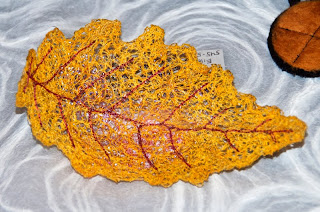
Embroidery has been seen to embellish fiber/fabric works by adding line and/or pattern. An additional way that embroidery can enhance fiberart is by creating texture.
In hand embroidery, texture may result from directional stitching as well as lumpy stitches such as those that produce loops or knots. Couching can also be used to hold down textured threads like thick and thin yarns, bouchles, eyelash yarns. Couching may be done by hand or machine. A third possibility is to use stitches to attach three dimensional objects such as beads, buttons, wads of fabric or found objects.
In machine embroidery, the stitches are formed by two threads looping together within the fabric--one from the spool on the top and one from the bobbin below. In a normal sewing line, the tensions of the top and bottom threads are balanced such that only the top thread is visible on the surface of the fabric and only the bobbin thread is visible on the back side. If the tension is not balanced, loops and nubs of thread can be produced either on the top surface (tighten top and or loosen bobbin tension) or on the bottom (loosen top and/or tighten bobbin tension). Either top or bottom can become the "right" side of the finished piece. In addition, thicker threads may be wound on the bobbin so that sewing may be done with threads too heavy to pass through the eye of the needle. In this case, the bottom will become the "right" side and the design must be stitched from the "wrong" side.
Julie Booth uses directional hand stitching to add texture to the lips and eyes of her totem dolls.
Direction of stitching also figures in the machine embroidery "Three Apples" buy Joanne Bast to differentiate the texture of the painted windows from the cement sill and the apple skins.

When the background strata is thick, stitching lines compress areas and puff out others as in the wet felted wool wall hanging "scaling the Great Wall" by Joanne Bast or the needle felted bracelets by Paige Garber.
Hand stitched seed beads, sequins, buttons, wire curlicues, carved stone flowers and/or fresh water pearls embellish felted brooches by Zita Simutis, Anne Sanderoff-Walker, Paige Garber, and Joanne Bast.




Olena Lar, one of our newest members stitches beads and stones onto a leather slave bracelet ring combination.

A textured evening bag by Beverly Baker combines couching and beading.

Ann Liddle and Eileen Doughty leave thread ends to texture necklaces of felt and paper.



Machine couching of a thick and thin yarn embellishes a purse by Dorothy Miller.
All over couching of a textured thread in a wall hanging by Fran Spader.

Couching only a few of the painted squares on Janet Barnard's scarf emphasizes shapes.

Anna Ebersole stitches bits of fabric and threads to form a 3Dimensional wall piece "Dragonflies".
Joanne Bast stitches leaf veins on a barrette using perle cotton in the bobbin from the wrong side and then turns the piece over to add the freeform stitching from the right side.
Eileen Doughty contrasts the texturing of freeform machine stitching with the straight stitching of the tree trunks in a blue satin bag and a Washington city scene.
 Joanne Bast uses loose bobbin tension to pull loops of thread up from the bobbin to texture barrettes and to add dimension to the flowers in the window boxes of the machine embroidery "Red Window".
Joanne Bast uses loose bobbin tension to pull loops of thread up from the bobbin to texture barrettes and to add dimension to the flowers in the window boxes of the machine embroidery "Red Window". 
Mother's Day is fast approaching. Come on in and see the variety of fiber work available in the Potomac Fiber Arts Gallery for gift giving. Hand made items become heirlooms to be treasured by generations and not duplicated. April is coming to an end and I will soon be turning the blog posting over to Floris Flam. I hope to blog once more before the week is out. Until then, Joanne


 The stitched scarf is submerged in water and soaked then rinsed.
The stitched scarf is submerged in water and soaked then rinsed.

















 The stitched scarf is submerged in water and soaked then rinsed.
The stitched scarf is submerged in water and soaked then rinsed.









































 Joanne Bast uses loose bobbin tension to pull loops of thread up from the bobbin to texture barrettes and to add dimension to the flowers in the window boxes of the machine embroidery "Red Window".
Joanne Bast uses loose bobbin tension to pull loops of thread up from the bobbin to texture barrettes and to add dimension to the flowers in the window boxes of the machine embroidery "Red Window". 
